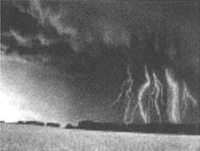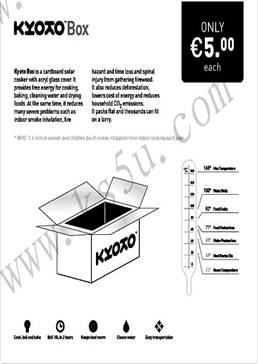
题目列表(包括答案和解析)
Earth is surrounded by a blanket of air, which we call the atmosphere. The atmosphere is the mixture of gases and other materials that surround the Earth in a thin, mostly transparent(透明的)shell. It is held in place by the Earth's gravity. It reaches over 560 kilometers (348 miles) from the surface of the Earth, so we are only able to see what occurs fairly close to the ground. Early attempts at studying the nature of the atmosphere used clues from the weather, the beautiful multi-colored(有多种不同颜色的)sunsets and sunrises, and the twinkling of stars. With the use of sensitive(灵敏的)instruments from space, we are able to get a better view of the functioning of our atmosphere.

Life on Earth would not be possible without the atmosphere. Obviously, it provides the oxygen we need to breathe. But it also serves other important functions. It moderates(缓和)the planet's temperature, reducing the extremes that occur on airless worlds. For example, temperatures on the moon range from 120℃ (about 250℉) in the day to -170℃ (about -275℉) at night. It also recycles water and other chemicals. The atmosphere also protects us by absorbing(吸收)and scattering(驱散)harmful radiation from the sun and space. Of the total amount of the sun's energy that reaches the Earth, 30% is reflected back into space by clouds and the Earth's surface. The atmosphere absorbs 19%. Only 51% is absorbed by the Earth's surface.
The density(密度)of air also decreases rapidly with altitude. At 3 km (2 miles) air density has decreased by 30%. People who normally live closer to sea level experience temporary breathing difficulties when traveling to these altitudes. The highest permanent human settlements are at about 4 km (3 miles) .
(1)The atmosphere is ________ .
[ ]
A.the cloud that surround the earth
B.a mixture of gases and other materials
C.the oxygen we need to breathe
D.a thin, mostly transparent shell
(2)Temperatures on the moon vary greatly between day and night probably because ________ .
[ ]
A.the density of air on the moon is so tow
B.it is very far from the sun
C.it doesn't have the atmosphere as the earth.
D.it has a lot of radiation
(3)What is the main idea of the passage?
[ ]
A.What the atmosphere is and the functions of it(作用).
B.What the atmosphere is made up of.
C.The density of air decreases with altitude.
D.The atmosphere can moderate the temperatures on the earth.
(4)From the last paragraph we may know that ________ .
[ ]
A.the density of air in the areas close to sea level is thinner than that in the mountainous areas
B.the higher people live, the better the air is
C.the density of air in the mountainous areas is thinner than that in the coastal areas
D.people like to live in the high altitude rather than in the low altitude
Earth is surrounded by a blanket of air, which we call the atmosphere. The atmosphere is the mixture of gases and other materials that surround the Earth in a thin, mostly transparent(透明的)shell. It is held in place by the Earth's gravity. It reaches over 560 kilometers (348 miles) from the surface of the Earth, so we are only able to see what occurs fairly close to the ground. Early attempts at studying the nature of the atmosphere used clues from the weather, the beautiful multi-colored(有多种不同颜色的)sunsets and sunrises, and the twinkling of stars. With the use of sensitive(灵敏的)instruments from space, we are able to get a better view of the functioning of our atmosphere.

Life on Earth would not be possible without the atmosphere. Obviously, it provides the oxygen we need to breathe. But it also serves other important functions. It moderates(缓和)the planet's temperature, reducing the extremes that occur on airless worlds. For example, temperatures on the moon range from 120℃ (about 250℉) in the day to -170℃ (about -275℉) at night. It also recycles water and other chemicals. The atmosphere also protects us by absorbing(吸收)and scattering(驱散)harmful radiation from the sun and space. Of the total amount of the sun's energy that reaches the Earth, 30% is reflected back into space by clouds and the Earth's surface. The atmosphere absorbs 19%. Only 51% is absorbed by the Earth's surface.
The density(密度)of air also decreases rapidly with altitude. At 3 km (2 miles) air density has decreased by 30%. People who normally live closer to sea level experience temporary breathing difficulties when traveling to these altitudes. The highest permanent human settlements are at about 4 km (3 miles) .
(1)The atmosphere is ________ .
[ ]
A.the cloud that surround the earth
B.a mixture of gases and other materials
C.the oxygen we need to breathe
D.a thin, mostly transparent shell
(2)Temperatures on the moon vary greatly between day and night probably because ________ .
[ ]
A.the density of air on the moon is so tow
B.it is very far from the sun
C.it doesn't have the atmosphere as the earth.
D.it has a lot of radiation
(3)What is the main idea of the passage?
[ ]
A.What the atmosphere is and the functions of it(作用).
B.What the atmosphere is made up of.
C.The density of air decreases with altitude.
D.The atmosphere can moderate the temperatures on the earth.
(4)From the last paragraph we may know that ________ .
[ ]
A.the density of air in the areas close to sea level is thinner than that in the mountainous areas
B.the higher people live, the better the air is
C.the density of air in the mountainous areas is thinner than that in the coastal areas
D.people like to live in the high altitude rather than in the low altitude
| |||||||||||||||||||||||||||||||||||||||||||||||||||||||||||
阅读理解:阅读下列短文,从每题所给的四个选项(A、B、C和D)中,选出最佳选项.
China became the 143rd member of the World Trade Organization (WTO) on December 11, ending its 15-year request to join the global trade club.
The country was accepted at WTO's fourth ministerial meeting in Doha, capital of Qatar.
The Chinese government hopes WTO membership will boost (推进) reform and opening up and give companies greater access (进入) to the global market.
It has promised to abide by all its commitments (承诺) during its talks with WTO members and create a steady, transparent (透明的) and fair trade environment in line with WTO requirements.
Already, the country has revised and got rid of hundreds of laws and regulations that were against WTO rules, and organized training courses for civil servants, business personnel and citizens.
Experts say China's accession to the WTO will push forward the country's market-oriented reforms and help reshape its political, economic, legal and social structures.
Foreign companies believe the move provides greater access to the world's largest untouched market and will help improve the country's investment environment.
The Ministry of Foreign Trade and Economic Cooperation has released (发布) on its website the original English version and the Chinese translation of the legal documents on China's WTO entry.
The People's Publishing House and the Law Publishing House have been authorized to publish two series of books on the legal documents by early next year.
1.Which of the following will be the best title of the passage?
[ ]
A.China's Accession to the WTO
B.Why does China join the WTO?
C.The 143rd Member of the WTO
D.WTO Membership Will Boost(促进) China's Reform & Opening UP
2.What can be inferred from. the passage?
[ ]
A.China's accession to the WTO will push forward the country's market-oriented reforms.
B.Two series of books on the legal documents will be published early next year.
C.The competition of educated people among companies will be more hard.
D.China is creating a steady, transparent and fair trade environment in line with WTO requirements.
3.Where can this passage most probably appear?
[ ]
A.In a newspaper.
B.In a magazine.
C.In a book on China's economy.
D.In a book on WTO.
4.In this passage, the writer tells us that ________.
[ ]
A.China has joined the WTO successfully
B.what China has done after its accession to the WTO
C.the whole country are celebrating the China's accession to the WTO
D.the importance of China's accession to the WTO
A $6 cardboard box that uses solar power to cook food, clean water and could help 3 billion poor people cut greenhouse gases, has won a $75,000 prize for ideas to fight global warming
 The Box, named after the United Nations’ Kyoto Protocol that seeks to cut greenhouse gases, is aimed at billions of people who use firewood to cook. It can also make it easier to boil polluted water. The Kenyan-based inventor hopes it can make solar cooking widespread in the developing world, replacing the use of wood which is driving deforestation. Organized by Forum for the Future, the competition aims to support concepts that have “moved off the drawing board and demonstrated their feasibility” for reducing greenhouse gases.
The Box, named after the United Nations’ Kyoto Protocol that seeks to cut greenhouse gases, is aimed at billions of people who use firewood to cook. It can also make it easier to boil polluted water. The Kenyan-based inventor hopes it can make solar cooking widespread in the developing world, replacing the use of wood which is driving deforestation. Organized by Forum for the Future, the competition aims to support concepts that have “moved off the drawing board and demonstrated their feasibility” for reducing greenhouse gases.
“The Kyoto Box has the potential to transform millions of lives,” said Peter Madden, the forum’s chief executive. The box is made from two cardboard boxes, which use reflective foil(箔)and black paint to maximize absorption of solar energy. Covering the cooking pot with a transparent(透明的)cover keeps heat and water, and temperatures inside the pot can reach at least 80C.
The idea of cooking using the Sun’s rays has been around for centuries, and a number of organizations including Solar Cookers International are already supporting their manufacture and distribution in the developing world. The Kyoto Box also improves the health of villagers who do not have to spend hours taking in wood smoke, a major cause of respiratory disease(呼吸道疾病).
Many countries are looking for cheap green ways to stimulate economies mired in economic crisis. More than 190 nations have agreed to work out a new U.N. climate pact to succeed Kyoto at a meeting in
66. What’s the main purpose of the Kyoto Box?
A. To warn people of the dangers of global warming.
B. To encourage more villagers to use firewood to cook.
C. To earn money from rural areas in developing countries.
D. To transform the lives of villagers in developing countries.
67. We can learn from Paragraph 2 that _________.
A. solar cooking is unlikely to be widespread
B. the invention helps to preserve the forest
C. Kyoto Protocol is mainly about green food
D. greenhouse gases are mainly caused by firewood
68. Which of the following is NOT true about The Kyoto Box?
A. It is convenient and environment-friendly.
B. It does good to the people’s health in rural areas.
C. It makes it possible for more poor people to afford it.
D. It was invented several hundred years ago.
69. It can be inferred from the passage that __________.
A. the cardboard box can be used to cure diseases
B. more nations are interested in the invention
C. black objects readily reflect more light
D. the invention can accelerate economic crisis
70. What would be the best title for the text?
A. Solar-powered Cooker Wins Climate Prize
B. Cardboard Box Boils Polluted Water Easily
C. Alternative Energy Found in Rural Areas
D. Meeting Held in
湖北省互联网违法和不良信息举报平台 | 网上有害信息举报专区 | 电信诈骗举报专区 | 涉历史虚无主义有害信息举报专区 | 涉企侵权举报专区
违法和不良信息举报电话:027-86699610 举报邮箱:58377363@163.com